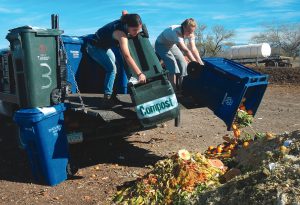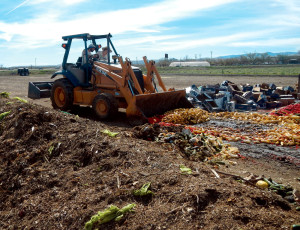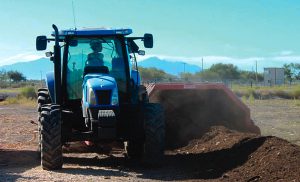A student group at the University of Arizona, the City of Tucson and a Native American tribe joined forces to collect and compost source separated organics.
Dan Emerson
BioCycle August 2014
In Pima County, Arizona, the City of Tucson has partnered with the University of Arizona and its 14-member student government-run program, Compost Cats — as well as the San Xavier Cooperative Association on the Tohono O’odham Reservation and the Community Food Bank of Southern Arizona — to collect and compost commercial food scraps, manure and yard trimmings. Under an agreement that took effect in late February, the city provides a central food waste collection station for Compost Cats and transportation of material to San Xavier Co-op Farm.

University of Arizona student members of Compost Cats work at
the composting site located at the San Xavier Co-op Farm. Photo courtesy of Compost Cats
The farm, owned by the Tohono O’odham Nation, a federally recognized Native American tribe located in southwestern and central Arizona, has provided a 10-acre area for the Cats’ composting operation. The farm, which is about five miles outside of Tucson, also provides a tractor and watering truck in addition to some labor, according to Propagation Manager Cie’na Schlaefli.
Project Origins
The food waste diversion idea originated several years ago with University of Arizona (UA) students “who wanted to find a better use (than landfilling) for the food waste from the student union,” says Chet Phillips, an instructor and Arid Lands Resource Sciences doctoral student who was hired in 2010 to make the idea a reality. “The more we learned about the scale of food waste, especially in southern Arizona, the more we realized the societal need to address the problem, and that there was an opportunity to turn (waste) into a community asset for soil fertility.” Phillips also gathered data from an area landfill to gauge the quantity of food waste being disposed. It showed that the landfill received nearly 3,500 tons/month of food waste in 2011 and 2012, most of which was food that crossed the U.S.-Mexico border at Nogales bound for grocery stores across the nation but then was judged not fresh enough to make it to its final destination.
Compost Cats’ food waste collection and composting began about three years ago with waste from UA student union restaurants, and then expanded to local businesses and the city government. So far more than 7,500 tons of food waste have been diverted, according to Phillips. Compost Cats began composting on two acres at the campus agricultural center but quickly outgrew that site. Phillips then contacted the Community Food Bank of southern Arizona, which referred him to the San Xavier Co-op Farm. The composting operation moved to San Xavier Co-op Farm in June 2013.
When word got out about UA’s food waste composting program, local businesses began asking for food waste pick up, including two Whole Foods stores, two Starbucks, and several restaurants and independent coffee shops. Compost Cats offered a twice-daily food waste collection run, and businesses could select the number of weekly pick ups needed. Since February, food waste has been taken to the Reid Park Zoo, which provides the Cats a nearby city location to unload collected food waste. City workers then take these materials to the farm. The Compost Cats have been collecting about 5 tons/week of food waste from local businesses (which is changing with the start of a new city pilot project (see below)).
The City of Tucson also delivers 15 tons/week of manure from herbivores at its Reid Park Zoo, along with landscaping waste from the maintenance of city parks, to the composting facility, notes Fran LaSala, Environmental Manager with the City of Tucson Environmental Services. The Cats also compost manure provided by other farms in the area.
Aware that 27 percent of children in Arizona are, by federal government standards, “food insecure,” Compost Cats has also partnered with both major food banks in southern Arizona — the Borderlands Food Bank and Community Food Bank of Southern Arizona. “We want all the food that could feed people to go to them first, then we take the rest,” says Phillips. “The Borderland Food Bank has been delivering two to three semi truckloads (about 20 tons/load) of fruit and vegetable waste to the farm each week.”

Green waste, food scraps and manure are delivered six days a week and piled into a windrow using a front-end loader. Photo courtesy of Compost Cats
Composting Logistics
The Compost Cats currently use about 3 acres on the Co-op Farm for the composting operation, with room for eventual expansion up to 10 acres as the program continues to grow. Green waste, food scraps and manure are delivered six days a week. Once delivered, the material is piled in windrows, each several hundred feet long and about four feet high. Because of the arid climate, the rows are watered and turned twice weekly using a New Holland tractor pulling a HCL CT-10 compost turner. It takes three-and-a-half to four months before compost is ready for screening. Product is screened to both a quarter-inch and one-half inch using an EZ Screen 1000XL sifter. Students use a Solvita kit to test the piles every couple of weeks for maturity. A local laboratory provides an annual breakdown of micronutrients in the compost.
The San Xavier Co-op Farm just recently began using Compost Cat compost on its own crops. It receives 20 percent of the compost produced in exchange for use of the land, some equipment and water. The 860-acre farm has been run by the San Xavier Cooperative Association since the 1970s, growing grains and various vegetables and fruits. The farm had previously done vermicomposting but its partnership with the Compost Cats is its first large-scale composting operation. “The soils here are very alkaline and lack organic matter,” explains Cie’na Schlaefli. “Using the compost, we should start seeing a difference (in crop yields) in the next couple of years.”

Because of the arid climate, windrows are watered and turned twice weekly with an HCL CT-10 compost turner. Photo courtesy of Compost Cats
Compost Cats also provides compost to the food banks for their gardening programs for low-income families, as well as donates material to local school gardens. In addition, Compost Cats has been selling in bulk and in 1 cubic-foot bags (for about $10 each) to local resorts, landscapers, a food co-op and home gardeners. Students do the bagging using a machine built by university engineering students.
A student fee-funded “Green Fund” provides financing for about a dozen part-time Compost Cat student jobs. The group has developed a 5-year plan to become financially independent and pay for its operations from the proceeds of compost sales.
Collection Transition
Starting July 1, 2014, the City of Tucson’s Environmental Service Department took over collection of food waste from local businesses that have been serviced by the Compost Cats and is expanding the program. “We will both play to our strengths — we can haul and the students will provide quality control and composting,” explains LaSala. “The city will try it out as a one-year pilot project to evaluate our expenses and find out if the program is viable.”
The city has already been approached by a local grocery store chain to explore the possibility of collecting its food waste, as has a local call center with 800 employees that wants to divert from its cafeteria. “The grocery stores are looking to offset their trash disposal costs and others just want to compost,” notes LaSala. “Either way we will do our best to accommodate them and hopefully save them money and help achieve their ‘green goals’.” To ensure the commercial food waste pilot stays within the city’s budget, he adds that officials want to gradually expand collection on a route-by-route basis, “not in a piecemeal way.”
The Compost Cats’ food waste diversion program was recently recognized with the Arizona Recycling Coalition’s 2013 Recycler of the Year Award.
Dan Emerson is a Contributing Editor to BioCycle.















